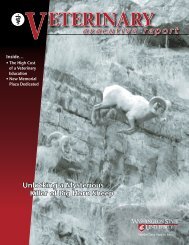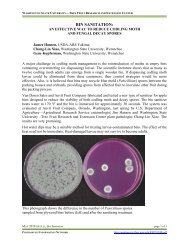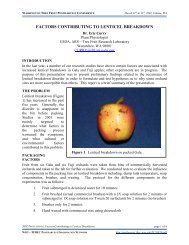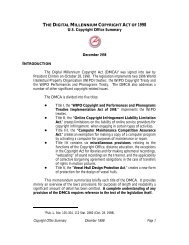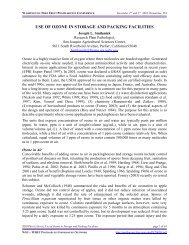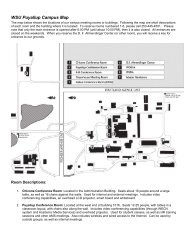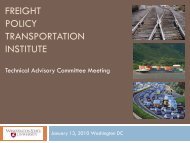Climate Action Plan - ACUPCC Reports - Climate Commitment
Climate Action Plan - ACUPCC Reports - Climate Commitment
Climate Action Plan - ACUPCC Reports - Climate Commitment
- No tags were found...
Create successful ePaper yourself
Turn your PDF publications into a flip-book with our unique Google optimized e-Paper software.
<strong>Climate</strong> <strong>Action</strong> <strong>Plan</strong>
greenhouse gas inventoriesgreen developmentenergy conservationtransportationcarbon offsetsI am pleased to present the Washington State University <strong>Climate</strong> <strong>Action</strong> <strong>Plan</strong>s, the result of acollaborative planning process that has brought student, faculty, and staff representatives from across ouruniversity’s campuses together in pursuit of a common goal.In forging a more sustainable future, a major research university must play many roles. First, we as aninstitution must act as a good steward of our environment.This fall we opened the first new residence hall we have built on our campus in nearly four decades. Theproject is anticipating a LEED Silver rating. Innovative “green” strategies are incorporated in itsconstruction and operation, including geothermal heating and cooling, natural day lighting, natural habitatand vegetation, water efficient landscaping, use of regional and recycled materials where possible. Theopening of this structure comes one year after the opening of our first LEED certified building, therenovated Compton Union Building that serves as the center for student life on campus.Constructed in 2003-2004 on our Pullman campus, the Grimes Way Steam <strong>Plan</strong>t replaced an existingcoal-fired power plant that had been in service since 1936. Changing fuels from coal to natural gas as aprimary fuel allowed us to find cleaner and more efficient ways to heat our university. Both in 1988 and2004, WSU received the Governor’s Energy Team Award for Excellence in Energy Management.WSU has a history of excellence in the fields of electric power and energy systems. Researchers in theCollege of Engineering and Architecture are working to develop and incorporate new technologies aimedat improving the efficiency and reliability of the power grid. WSU Extension faculty members developand provide education to the public on energy and environmental issues. Through our research onrenewable energy sources, sustainable agricultural practices and the effects of global climate change,WSU is helping chart the course to a more sustainable future. Through the education and research carriedout in our Institute for Sustainable Design and our Center for Sustaining Agriculture and NaturalResources, we are encouraging environmental leadership. We are proud of how far we have come atWSU and are fully aware that our initiatives must continue. This climate action plan will assist us in thoseefforts.Elson S. Floyd, Ph.D.President3Washington State University
20002005201020152020202520302035204020452050<strong>Climate</strong> <strong>Action</strong> <strong>Plan</strong> Goals andStrategiesWashington State University’s (WSU) Sustainability Initiative - Executive Policy # 24 vision isfor “WSU to seek to provide an exemplary teaching, research, and outreach environment thatfosters the conservation of natural resources, supports and enhances social responsibility,addresses community and economic development, and follows environmental, social, andeconomic practices. “The <strong>Climate</strong> <strong>Action</strong> <strong>Plan</strong> (CAP) helps to implement WSU’s Sustainability Initiative and will alsohelp WSU attain three major goals:Goal 1Goal 2Goal 3Support and implement WSU’s strategic plan goals and missionMeet the American College and University President’s <strong>Climate</strong><strong>Commitment</strong> (<strong>ACUPCC</strong>)Meet Environmental Protection Agency (EPA) and WashingtonDepartment of Ecology (WDOE) greenhouse gas and climate changeregulationsThis <strong>Climate</strong> <strong>Action</strong> <strong>Plan</strong> provides a framework for WSU’s faculty, students and staff to worktogether and make short and long range decisions that will result in real, measurable reductionsin greenhouse gas (GHG) emissions. Progress will be tracked using a recognized greenhouse gasinventory tool using metric tons of carbon dioxide equivalents (mt eCO 2 ).Benchmarks will include meetingthe requirements passed into lawby the Washington Statelegislature in April 2009. Thesebenchmarks are reducing ourgreenhouse gas emissions by 15%of 2005 levels by 2020 (WDOEbenchmark # 1) and by 36% of2005 levels by 2035 (WDOEbenchmark # 2).mt eCO 2WSU's Projected Annual GHG Emissions350000300000250000200000150000100000500000Business asUsualCurrentEmissionsWDOEBenchmark# 1WDOEBenchmark# 24Washington State University
<strong>Climate</strong> <strong>Action</strong> <strong>Plan</strong> Goals andStrategiesWhile climate neutrality is not a requirement of Washington legislation, as a signatory to theAmerican College and UniversityPresident’s <strong>Climate</strong> <strong>Commitment</strong>, WSUhas pledged to work towards net climateneutrality. Given the long time line for thisCAP, the technological advances that willoccur and an uncertain budgetary future,WSU cannot, at this time, predict orcommit to a specific date to achieve netclimate neutrality. WSU’s innovativeresearch will help to accelerate achievingnet climate neutrality at WSU, in the state,and beyond.To achieve our greenhouse gas reductiongoals, WSU will implement four majorstrategies.‣ green development‣ energy conservation‣ transportation‣ carbon offsetsThis CAP will be a living document. It will be continually modified to react to changingtechnologies, opportunities, innovations and a changing regional and world climate.5Washington State University
greenhouse gas inventoriesgreen developmentenergy conservationtransportationcarbon offsetsGreenhouse gasses (GHG) include carbon dioxide (CO 2 ), nitrous oxides, methane, refrigerants,and other chemicals, each with a different global warming potential (GWP).Carbon dioxide is the standard by which all other GHG are normalized; carbon dioxide’s GWP is1. For instance one metric ton of methane has the global warming potential of 21 metric tons ofCO 2 . The following table shows the GWP of the various types of greenhouse gasses.Carbon Dioxide (CO 2 ) GWP = 1Methane GWP = 21Nitrous Oxide GWP = 310Hydrofluorocarbons GWP = 12 – 11,700Perfluorocarbons GWP = 6,500 - 9,200Sulfur Hexafluoride GWP = 23,900Total greenhouse gas emissions from an entity are reported in equivalent metric tons of CO 2(eCO 2 )WSU's Primary Emissions Sources3% 3% 2% 1% 1%38%52%PurchasedelectricityStationarycombustionFugitive emissionsDaily commutingSolid wasteUniversity fleetvehiclesUniversity air travel6Washington State University
Greenhouse Gas InventoriesWSU - Pullman Greenhouse Gas Sources 2008Equivalent Metric Tons- eCO 2Percent1. Purchased electricity 72,988 52%(With transmissionand distribution losses)2, Stationary combustion 53,922 38%(Fuel burned in the steam plant,incinerator, and other boilers)3. Fugitive emissions 3,965 3%(Refrigerant losses and livestock)4. Daily Commuting 3,764 3%(Faculty, staff, and students)5. Solid Waste 2,417 2%(eCO 2 in incinerated waste,Methane from Landfill)6. University Fleet Vehicles 1,918 1%7. University Air Travel 1,030 1%Gross Metric Tons eCO 2 140,0048. Carbon Offsets - -3,838 - 3%(Composting)Net Metric Tons eCO 2 136,16614012010080604020-20 0eCO 2 (k metric tons)160ComponentEmissionsNet emissions7Washington State University
eCO 2 (metric tons x 1,000)Greenhouse Gas InventoriesFrom 2000 to 2003 WSU’s emissions grew an average of 1.5 % per year. A growth rate of 1.5% wasused to project WSU’s emissions into the future.The jump in emissions in 2001 was from two temporary diesel boilers that were brought on to campus tobackup the boilers at the old steam plant; they used almost 400,000 gallons of diesel fuel.Design and construction of the new steam plant began in 2000. The new steam plant uses natural gasand diesel fuel to produce steam for the University instead of coal.In 2004, WSU began part-time operation of its new steam plant. In 2005 WSU’s greenhouse gasemissions dropped over 9% compared to “business as usual” projected emissions as the new steam plantwent into full time operation.From 2005 to 2008 increases in the quantity of diesel burned and campus growth accounts forthe increase in greenhouse gas emissions.160WSU Pullman GHG Emissions 2000 - 2008155150145140135WSU's GHGEmissionsBusiness as usual1301258Washington State University
greenhouse gas inventoriesgreen developmentenergy conservationtransportationcarbon offsetsBackgroundEach year the built environment consumes significant amounts of the nation’s raw materials(40%), total energy produced (33%), and fresh water (17%). The challenge is to designintelligent, economically prudent projects that use a minimum of non-renewable energy, producea minimum of pollution and wastes, and are generally environmentally benign; all the whileincreasing the safety, comfort, and health of the people who live and work in them.In 2005 the State of Washington legislature passed Senate Bill 5509 which stated all state fundedbuildings over 5,000 square feet of conditioned or occupied space, should meet at least theUnited States Green Building Council’s Leadership in Energy and Environmental Design’s SilverStandard. There are four levels of project Certification (from lowest to highest): Certified,Silver, Gold, and Platinum.Washington State University has been a member of the U.S. Green Building Council (USGBC)since 2006. The Leadership in Energy and Environmental Design (LEED) green building ratingsystem is a nationally accepted benchmark for the design, construction, and operation of highperformance green buildings.The philosophy of building construction here at WSU has long been one of building sustainablefacilities. Because of our nature we want our buildings to last 100 years or more. This is evenmore important in a time of dwindling resources and construction money.StrategiesWashington State University campuses promote innovative, sustainable design and constructionprinciples that improve safety,9Washington State University
Green Developmentfunctionality, and energy efficiency that mirrors our respect for campus culture and heritage.Several innovative “green” strategies are incorporated into WSU's new buildings, includinggeothermal heating and cooling, natural day lighting, sun shadingdevices to minimize heat load, site restoration with natural habitat and vegetation, water efficientlandscaping, stormwater collection and reuse for irrigation, high reflective roof to reduce heatisland effect, reduction of light pollution, educational signage system, water-use reduction in thebuilding, construction waste management, use of regional materials, recycled materials andcertified wood where possible.More than twenty years ago Washington State University (WSU) built one of the first greenroofs in the State of Washington over Terrell Library.In the late 1970’s and early 1980’s WSU, in collaboration with Gear Powers developed acampus-wide building automation system. With this system we were able to remotely monitorand manipulate the heating, ventilation, and air conditioning of the building. This technique wasultimately acquired by Siemens, which is recognized as one of the premier suppliers of buildingautomation systems worldwide.At WSU, we are proud of our record in water conservation. Water consumed annually on thePullman campus over the last two decades has decreased by thirty-one percent, from 681 milliongallons in 1986 to 478 million gallons in 2006. During that same time, the enrollment increasedby nearly 2,500 students and the square footage of campus facilities increased by twenty-sixpercent. The real story about WSU water conservation is one of innovation, progress, and socialresponsibility demonstrated by initiatives such as:‣ Construction of a more water efficient steam plant that saves WSU approximately 30million gallons per year.‣ Aggressive efforts in leak detection and repair resulting in water savings of 11.5 milliongallons per year,‣ Elimination of water wasting equipment garnering another 10 million gallons annually inwater savings.PastIt has been said the most sustainable building is one that is already built. At115 years old Thompson Hall is truly a fine example of a sustainable building.Built in 1894 it is the oldest extant building on campus, and was constructedfor less then $50,000 using local red brick made from clay deposits taken oneblock away. Until 1968, it served as the Administration building as well ashousing a number of other university functions. During the next 30 years,dozens of buildings were constructed as the college grew, including 20 that arestill in use today as classrooms, offices, and dormitories.ThompsonHall1894 andtoday10Washington State University
Green DevelopmentEnergy <strong>Plan</strong>tThe new central steam plant on Olympia Avenue has been providing steam since 2005 andreplaced the old coal-fired steam plant on College Avenue. The two new packaged-unit boilersat the existing plant (Boilers 1 and 2) have been retained as a satellite facility, and together thetwo plants supply 100 percent of the campus' steam needs. Primary equipment at the new centralplant includes three boilers (capable of producing up to 83,000 lb/hour steam supply each) andthree each Reciprocating Internal Combustion Engine-Generators with a combined generationcapacity of approximately 2.7 megawatts. The fuel resource f or the new boilers is natural gaswith diesel backup. Certain steam system upgrades were implemented to support the newfacility, including: upsize of approximately 900 linear feet of existing piping on Grimes Wayfrom the new plant to Quad-Services Road; rework of condensate handling facilities at theexisting plant; and conversion of the two pressure (60 and 200 psi) distribution system to a single100 psi system. This project is in response to bothsafety and reliability concerns expressed through anEmergency Declaration made by WSU in August2000. New facilities assure WSU's goal in assuringplant safety, reliability, increased fuel and operatingefficiencies, energy conservation and environmentalquality. In meeting both current and future needsfor steam and electricity, the completed projectlimits WSU’s exposure to fluctuations in utilitiespricing, thereby offering potentially substantialsavings in future operating costs.PresentCompton Union Building (CUB)Built in 1951 and first renovated in 1968 this building was in need of mechanical and electricalupgrades of inefficient systems and a cosmetic face-lift including insulated glazing. The mostrecent renovation was begun in 2006. Sustainability and energy efficiency are primary objectivesof the renovation. For example, chilled beams were used to provide radiant heating and coolingto much of the building. Also, low VOC paints and adhesives were used for the finishes.During the renovation the bulk of the existing buildingwas demolished, retaining only the core structure andexterior shell. The building was expanded slightly atthe ballroom and lower levels to total 235,000 squarefeet. Major architectural improvements include a stairand elevator tower from field level at the north, anassociated pedestrian bridge to the first floor, andrevised exterior entry and landscape elements onTerrell Mall. Mechanical, electrical, and plumbingsystems have been replaced in their entirety.11Washington State University
Green DevelopmentThe renovated CUB is now fully air conditioned.The renovated CUB project was completed in August 2008. The USGBC awarded the CUB LEEDSilver Certification in 2009, thus making it the first LEED certified WSU facility.Olympia Avenue Student HousingThe first dormitory built on campus since 1972, this project is anticipating LEED SilverCertification while maintaining WSU's distinctive materials palette. Several innovativesustainable strategies are incorporated intothis 76,000 square foot building housingover 230 students including geothermalheating and cooling, natural day lighting,sun shading devices to minimize heatload, site restoration with natural habitatand vegetation, water efficientlandscaping, stormwater collection andreuse for irrigation, high reflective roof toreduce heat island effect, reduction oflight pollution, educational signage system, water-use reduction in the building, constructionwaste management, use of regional materials, recycled materials and certified wood wherepossible. Olympia Avenue Student Housing was opened for student occupation in August 2009.Clubhouse at Palouse Ridge Golf ClubThe Clubhouse at Palouse Ridge Golf Club(PRGC) is not a LEED registered project.However, several sustainable features areincorporated in the design of the Clubhouse.They include polished concrete floors, largeoverhangs, and the first closed loop groundsource heat pump for heating and cooling ofany WSU facility. Located in the center ofPRGC, the Clubhouse provides expansiveviews of the Palouse hills, and is becominga destination for alumni and visitors to Pullman. The 7,150 square foot Clubhouse servesstudents, faculty/staff, and community users, and has the capacity to host 80-100 guests forspecial events. Construction began in September 2007, and was completed in August 2008.12Washington State University
Green DevelopmentEast Campus Chilled Water FacilityThis was a design-build project utilizing the Energy Services Performance Contracting (ESPC)process to provide additional production andsupply of chilled water for the campus.Chilled water is used for the cooling ofbuilding environments during the year.Washington State University currently utilizescentral chilled water production anddistribution system to supply cooling forvarious buildings and facilities on campus.The use of a central system in lieu ofindividual chiller plants at each building savesconsiderable energy, operational, andmaintenance resources. This project willenhance these resource savings and supportthe current and future demands for cooling throughout the campus.The project will initially provide for 3,000 tons of cooling capacity. The building is designed andconstructed such that additional cooling capacity up to a total of 9,000 tons can be added in thefuture as demand growth dictates. The project also provides an expansion of the 13.2kVelectrical distribution system from the Terra View Road substation to the new chilled water plantand to other areas of campus to meet the current and future needs for electrical energy on thePullman campus. Construction was completed in 2009 and the facility is online producingchilled water to meet the cooling needs of the campus. The close-out phase of the projectincludes verification of energy savings during the peak of the cooling season.FutureVeterinary Medical Research Science BuildingThe Veterinary Medical Research Science Building will provide approximately 128,000 grosssquare feet located within the Research and Education Complex on the Pullman campus. Thebuilding will provide properly equippedand environmentally controlled, state-ofthe-artbiomedical research and supportspace for the health science teaching andresearch programs. A vivarium is alsoincluded to provide modern animalholding facilities for gene targeted andknockout animals, as well as to provideessential quarantine space and specializedenvironmentally controlled space forbiomedical research.a13Washington State University
Green DevelopmentBecause this is a research facility it is not mandated by the State of Washington to meet LEEDstandards. However, WSU strives to design all buildings with sustainable goals in mind. To thatend, a one day eco-charette was held to brainstorm sustainable concepts that could beincorporated into the building. Some of those concepts included pervious concrete, buildingmounted photovoltaic panels, motion/light sensors, heating and cooling with ground source heatpump system.Global Animal HealthWSU’s College ofVeterinaryMedicine’sSeptember 2004Precinct Master <strong>Plan</strong>and subsequentupdates identifiedbuilding facilities insupport of theWSU’s School forGlobal AnimalHealth missions.Key is developmentof new facilities thatsupport the School’s infectious disease research and diagnostic programs. <strong>Plan</strong>ned atapproximately 40,000-45,000 gross square feet, the Phase I building program currently includesbiological safety levels 2 and 3 research laboratories for 12-15 principal investigators. A Phase IIbuilding, planned at approximately 75,000 gross square feet, includes biological safety level 2and 3 large and small animal necropsy laboratories, offices for faculty, DVM residents, and staff;and the School’s diagnostic program administrative space. These new facilities will be sited nearthe existing Animal Disease Biotechnology Facility (ADBF) and the Veterinary TeachingHospital, within the College of Veterinary Medicine Precinct on the WSU Pullman campus.14Washington State University
Green DevelopmentWSU Pullman Master <strong>Plan</strong>A new Master <strong>Plan</strong> Study of the Pullman campus will take place in 2010. The study willincorporate a number of sustainable components. Washington State University is engaged in aregular exercise of updating and expanding upon our Uniform Design and ConstructionStandards. These standards have an historic reference to and focus upon high performance,sustainable building design.As we plan for the future, WSU will continue to provide innovative, sustainable design andconstruction principles that improve safety, functionality and energy efficiency that mirrors ourrespect for campus culture and heritage.Pullman Statistics‣ Student Enrollment: 18,234‣ Total Building Square Footage: 10,532,164‣ Total Pullman Campus Acreage: 1,67515Washington State University
greenhouse gas inventoriesgreen developmentenergy conservationtransportationcarbon offsetsWSU has a long history of pursuing energy and resource conservation opportunities which havereduced greenhouse gas emissions.Steam <strong>Plan</strong>tIn 2004 a new steam plant went into operation. This eliminated theuse of coal on campus. This reduced steam plant greenhouse gasemissions from approximately 93,000 mt eCO 2 in 1990 toapproximately 55,000 mt eCO 2 annually today.High Efficiency Appliances137 high efficiency clothes washers have been installed in residencehalls and campus apartments. Each washer saves 40 gallons of waterper load saving water and energy. Another 80 washers are scheduledfor replacement in the near future.Energy Services Performance Contracting (ESPC) ProjectsSince 2001, WSU has been partnering with an energy/resourceconsultant to evaluate and pursue ESPC projects that saveenergy/resources and are cost effective. These projects include:‣ Campus-wide lighting upgrades‣ Heating, Ventilation and Air Conditioning upgrades‣ Chilled water system upgrades including a new central chilledwater plant‣ Greenhouse lighting and controls upgradesIn 2008, the completed ESPC projects reduced WSU greenhouse gasemissions by over 10,000 mt eCO 2 annually. New projects are beingevaluated and funded if they are economically feasible.16Washington State University
Energy ConservationBio-fuel source steam plantThe use of bio-fuels for steam generation on campus could significantly reduce WSU’sgreenhouse gas emissions. WSU is located in the heart ofthe Palouse, one of the most productive wheat growingregions in the world. More than 425,000 metric tons ofwheat straw is produced within fifty miles of the campusannually. This resource could provide the fuel for a newsteam plant providing baseline steam for the University(estimated at 88,000 mt of straw) annually supplementedwith natural gas in times of high demand.Optimize space utilizationInnovative management of WSU’s building spaces could slow campus growth, reduce the costand materials required for building new buildings and improve building space efficiency.Renewable energy credits - RECs— (i.e., wind farm generated electricity)RECs are available for purchase and they certify that a certain quantity for electricity has beengenerated from a qualifying type of renewable technology. “Green Tags” represent theenvironmental attributes of one megawatt hour of renewable energy that is physically meteredand verified. RECs are not offsets.PhotovoltaicPullman offers an opportunity for the use of photovoltaics. As new buildings are being designedthe addition of building integrated photovoltaics will be evaluated and pursued when costeffective.Light Emitting Diode (LED) lightingLED technology could greatly reduce the energy consumption for lighting. As this technologybecomes cost effective WSU will incorporate it into appropriate campus locations.Future technology improvementsAs the world moves toward carbon neutrality new technology will emerge that can assist theUniversity in its goal of becoming climate neutral.17Washington State University
greenhouse gas inventoriesgreen developmentenergy conservationtransportationcarbon offsetsAt WSU Pullman approximately 40% of the students live on campus and the majority of studentslive with in a few miles of campus. Most of the faculty and staff live within 15 miles of campus.Daily commuting, University owned fleet vehicles, and directly financed air travel areresponsible for approximately 5% of WSU Pullman’s greenhouse gas emissions.WSU Parking and Transportation Services offers several transportation alternatives thatencourage the use of mass transit, the use of car and van pools, and coordinates the WSU tripreduction and emergency ride home programs.These programs reduce WSU greenhouse gas emissions and help to achieve climate neutrality byreducing the combustion of fuel and release of greenhouse gas emissions.Wheatland ExpressWheatland Express operates a commuter bus between Moscow and Pullman. WSU faculty, staffand students can use the Wheatland Express for cross-listed courses, daily commutes, or forsight-seeing, shopping, or visiting in Pullman and Moscow.Wheatland Express also provides transportation for group charters, tours of the Palouse, and is alink between Pullman, Colfax, and the Spokane International Airport.18Washington State University
TransportationPullman TransitPullman Transit was established in 1979. Ridership the first year was approximately 300,000.The remainder of the 1980’s saw changes to the bus service that increased ridership to over600,000 riders per year.In 1991 WSU students voted to give Pullman Transit additional operating funds to increaseservice and allow students, staff, and faculty to ride free. Ridership on the bus service increasedto over 900,000.In 2003, WSU Students passed a measure to charge every student $15 per semester to improvebus service. As a result Pullman Transit ridership exceeded 1,000,000.In 2009, WSU students voted to increase theirstudent transit fee from $15 to $25 persemester. Bus ridership is expected to top1,300,000 rides.the country.Pullman Transit is considered to be one of themost cost effective and efficient systems inCarpool - E-Mail ListWSU-Carpool is an e-mail list sponsored by WSU Parking and Transportation Services. TheWSU-Carpool e-mail list was created to facilitate the exchange of carpool information for theWSU community. The list is for Washington State University Staff, Faculty and Students to postand review carpool information about rides needed as well as carpool openings.VanpoolsWSU Coordinated VanpoolsWSU Motor Pool coordinates vanpools from Palouse, Colfax, Colton, Uniontown, and theLewiston/Clarkston Valley.Whitman and Asotin County Public Transportation Area VanpoolsWhitman County and Asotin County operate a public transportation vanpool that is available toWSU faculty, staff and students.19Washington State University
TransportationOther ResourcesPalouseRideshare.orgThe Palouse Rideshare project is a web-based system designed to connect riders with drivers inthe Palouse region and beyond. Palouse Rideshare is intended to provide rider and driverconnections for those who commute or travel the same routes on a regular basis.RideshareOnline.comThe state of Washington has a source of ride share information that can be found at the web siteof RideshareOnline.com. This site offers a ride matching service for the entire state.CarpoolWorld.comAnother source of ride share information can be found at the web site of CarpoolWorld.com.This site offers a ride matching service for the entire planet. There are often people looking toshare the expense of a commute to school or work or even to Seattle for the weekend, andbeyond.Palouse Clearwater Environmental InstituteThe Palouse-Clearwater Environmental Institute, a nonprofit environmental organization, servesas a regional clearinghouse for car and vanpool information and provides Van Pool services forstudents and commuters on three different routes in the Palouse-Clearwater region. The routesinclude the following: Moscow-Lewiston, Lewiston-Moscow, and Moscow-Lapwai.Commute Trip ReductionWashington’s Commute Trip Reduction (CTR) Law seeks to identify and establish commutealternatives that could reduce employee single-occupant vehicle use. Reducing single occupantvehicle use in turn will reduce greenhouse gasses.Emergency Ride HomeIn order to promote alternatives to commuting in single-occupant vehicles, the Universitysupports the Emergency Ride Home program. This program provides assurance of a ride in anemergency for those who use alternative commute methods.20Washington State University
greenhouse gas inventoriesgreen developmentenergy conservationtransportationcarbon offsetsAfter implementation of the green development, energy conservation, and transportationstrategies to reduce greenhouse gas emissions, WSU may still not be able to achieve its climateaction plan goals. To reach regulatory mandated goals and, ultimately, the goal of net climateneutrality the use of carbon offsets may be required.A carbon offset is a way to mitigate GHG emissions that cannot be eliminated at WSU Pullman.Offsets are typically achieved through financial support of off-site projects that reduce theemission of greenhouse gases. Offsets may be less expensive than reducing WSU Pullman GHGemissions.Examples of typical carbon offsets that WSU may consider if necessary include off-site:‣ Renewable energy projects (e.g. wind farms or photovoltaic system)‣ Energy efficiency projects‣ Destruction of industrial pollutants (e.g. CFC capture and destruction)‣ Destruction of landfill methane‣ Composting agricultural/biological material‣ Land use changes (e.g. reforestation or afforestation)‣ Purchase of carbon offsets from recognized climate exchanges21Washington State University
If WSU purchases carbon offsets, they will be:‣ Real and measurable‣ Additional (emission reductions that would not have occurred otherwise)‣ Permanent‣ VerifiablePresent OffsetsCarbon OffsetsThe WSU Compost Facility supports Washington State University's missions by managing theUniversities organic waste stream in an efficient, effective and safe manner.The Compost Facility began operations in October 1994. The facility was the first universitybased compost facility to process all campus generated organic waste. Approximately 25,000cubic yards are composted annually on 4 acres of asphalt surface. Research has been conductedat the facility to determine how feedstocks affect quality and effectiveness ofinoculants and additives. The site isextensively toured by WSU compostclasses, local K-12 schools and otheruniversities.Feed stocks are mixed and composted for12 weeks. Piles are monitored fortemperature and turned weekly. The finalproduct is screened to remove anyresiduals larger than 3/4" and moved tocuring piles.The standard mixture in 2008 generally included feed stocks in these proportions:‣ 84% Animal manure and bedding‣ 7% Wood/paper waste‣ 5% <strong>Plan</strong>t waste and soil‣ 2% Laboratory animal waste‣ 2% Dining center food waste22Washington State University
Faculty - Education & ResearchPastThe faculty interested in environmental science began a process ofestablishing a strong foundation for their work almost a decade ago,motivated primarily by the broad recognition that while there were manyfaculty members involved in environmental research, education andoutreach work at the university – including faculty located on the maincampus in Pullman, and on WSU campuses in Spokane, Vancouver, theTri-Cities and throughout the WSU Extension system – these facultymembers were scattered across many different academic, research andoutreach units. In 2002 serious, persistent faculty-driven efforts wereinitiated to create a focal point for these faculty members to coalescearound in order to facilitate a more coherent approach to environmentalstudies at the university. In due course these faculty members succeededin convincing a cadre of five deans to support their efforts and succeeded as well in creating aformal proposal to create the Center for Educational Research, Education and Outreach[CEREO]. That proposal was accepted by the WSU Faculty Senate in 2006, and the university’sadministration recognized the new unit and allocated funds for its operations. At the presenttime more than 150 faculty members from throughout the university are participating membersof CEREO, and many of those faculty are actively engaged in the promotion of sustainabilitythrough the research, education and outreach work in which they engage. The creation of andthe activities of CEREO (see website) have resulted in three major accomplishments:‣ The creation of “roadmaps” for both undergraduate and graduate studies at WSU,allowing students and faculty alike to locate and take advantage of environmentalofferings at the university.‣ Support for the preparation of large, multi-disciplinary grant proposals to the NationalScience Foundation [NSF] (e.g., IGERT, NEON, ULTRA) and other funding sources tosupport research into sustainability.‣ The facilitation of outreach education and applied research in local communities seekingto promote sustainability through policy adoption and operational programs.PresentA number of faculty members involved in CEREO are in the process of carrying out theimplementation of the first large NSF grant secured with CEREO support. In August of 2009 theNSF awarded WSU a $3,000,000, 5-year grant entitled Nitrogen Systems: Policy-OrientedIntegrated Research and Education (NSPIRE) designed to support the graduate education of 30PhD students in Engineering and the Biological and Physical Sciences who are dedicated to theinterdisciplinary study of the nitrogen cycle with regard to the dynamics of global climatechange. In addition to carbon, reactive nitrogen in the environment represents a major problemfor ozone depletion and other environmental and public health hazards.CEREO is currently supporting five other multi-disciplinary groups of faculty engaged inconstructing other grant proposals such as the one formulated by the faculty members whoachieved NSF funding for NSPIRE. All of these efforts fit under the specific rubric ofenvironmental and societal sustainability.23Washington State University
Faculty - Education & ResearchRecently, the Department of Energy announced that a group of Washington State Universityresearchers will working with Avista on a demonstration project thathopes to make the city of Pullman the region’s first smart gridcommunity. The Pullman project is part of a Department of Energyregional smart grid demonstration project throughout the Northwestthat is designed to expand upon existing electric infrastructure and testnew smart grid technology. Using smart grid technologies, the PacificNorthwest Smart Grid Demonstration Project will test newcombinations of devices, software and advanced analytical tools thatenhance the power grid’s reliability and performance.FutureIt is anticipated that at least some of the faculty members involved inCEREO will focus their own work, and that of their students, on the following topics of directinterest to Washington State University. It is anticipated that grant applications and doctoraldissertation projects will be directed toward the following areas related to:‣ The study of carbon-generating, automobile-centered transportation systems at WSU,particularly with respect to the development of park n’ ride, bike, pedestrian and pooledconveyance modes of person transport and movement about the campus. The campusmaster plan for the next 10 years places a heavy emphasis upon ridding the centralcampus of automobile traffic.‣ The study of the possibility of a rail connection between Pullman and Spokane. This 75-mile corridor is increasingly heavily travelled, and the amount of future travel betweenthese two parts of the WSU main campus is likely to continue to increase. The HealthSciences focus of the Spokane campus make it likely that the Interdisciplinary DesignInstitute’s doctoral students will continue to scope out the feasibility of a rail connectionbetween Pullman and Spokane which would connect to the several small ruralcommunities along the route, all of which have given formal endorsements to the project.Preliminary studies indicate a strong interest in this possible future mode of travelbetween these two campus centers.‣ The promotion of distance learning, teleconferencing, and telecommuting has been anestablished set of initiatives for some time at WSU; however, as the nation approachesthe likelihood of the serious tracking of carbon emissions, some WSU faculty andgraduate students will very likely initiate studies designed to document the emissionsavoided by the adoption of alternatives to automobile and/or air travel to classes,meetings, and work.ConclusionThe <strong>Climate</strong> <strong>Action</strong> <strong>Plan</strong> for WSU will most certainly gain support from the many facultymembers who carry out research, education and/or outreach related to sustainability. With thecreation of CEREO is it likely that these efforts will be well-supported and coordinated, and thatthe President’s <strong>Climate</strong> <strong>Commitment</strong> will reach fruition at WSU.24Washington State University
Student InvolvementPastIn 1975, Associated Students of Washington State University (ASWSU) appointed a studentcommittee named the Environmental Task Force (ETF). Over the years ETF has focused itsefforts on many different environmental issues including air pollution and energy conservation.In the past few years ASWSU and the student body have been very supportive of green initiatives oncampus. They firmly stand behind the ethics and principles ofLEED certified building policies and alternative modes oftransportation. In 2008, students signed a petition backing theGreen Fund, which essentially gives each student the option toadd an additional charge on their semester fee to go towardsgreen initiatives on campus.In 2008, ASWSU allocated resources and supported theEnvironmental Wellbeing Coordinator (EWC) position withinthe Wellbeing program. The EWC’s job duties focus onsustainability, including the development of a bike shareprogram. The ultimate goal of the Green Bike program is toencourage a bike friendly culture on campus and to decrease airpollution and green house gas emissions. The program launchedin 2009 and continues to be well received by the WSU community. Additional, the EWC, along withstudents in ESRP 490 Environmental Management Systemsand Sustainability course, also created the WSU GreenLiving Guide which gives students information and tipsabout energy conservation and alternative modes oftransportation. The EWC also continues to provide educational programming that encourages studentsto decrease energy consumption by purchasing local products, weatherizing rooms/homes, and takingenergy audits.PresentCurrently there are 365 RSO’s on the WSU campus among those there are several that haveenvironmentally minded missions that focus on decreasing green house gas emissions and energy use oncampus.Environmental Science Club’s purpose is to give Washington State University students who arestudying environmental science and regional planning and related fields an opportunity to interact withtheir fellow peers who are interested in the well being of the environment and to work to improve theenvironment on campus and in the community. Currently, the club is focusing efforts on decreasingenergy consumption by asking academic departments on campus to agree to incorporate double sided25Washington State University
Student Involvementprinting as a policy for all class assignments, the English and History departments have already agreedto this for spring 2010.Engineers without Borders partners with Builders without BordersWSU in assisting disadvantaged communities across NorthwesternAmerica and around the world to improve quality of life throughsustainable, environmental, and economically sound engineeringprojects, all the while developing an internationally responsiblestudent body. Engineers without Boarders is designing andimplementing a renewable energy system at the WSU Organic Farm.Once the project is completed energy consumption at the Farm will be completely generated bysustainable means, deceasing energy use and ultimately air pollution.EWB highlights their wind turbineproto type at Spring Fest 2009Sustainable Ag Club’s mission of is to promote and implement sustainable social, economic andenvironmental agricultural practices by fostering multi-disciplinary relationships across campus and thelarger Pullman community through research, education, and advocacy. The clubs major initiative hasbeen to increase composting at individual levels and promote the use of the university compostingfacilities. They advocate composting as a way to save energy by converting our food scraps to soil.Students show their support in multiple ways; by allocating their fees to certain projects or by simplyparticipating in initiatives. Below are two current projects that are supported by ASWSU, RSO’s, andthe student body that specifically target air pollution and alternative green energy initiatives.Green Bike: This program presently offers for free or at a reduced cost 40 Mt. Bikes for students, staff,faculty and community members to use as an alternative mode transportation. The purpose of thisproject is to build a bike friendly culture on campus whilesimultaneously decreasing automobile congestion, noise and airpollution, and greenhouse gases. We also hope to increase physicalactivity and a sense of place through cycling. In the first semester ofthe program the bikes collectively traveled 3664 miles. If thosemiles had been driven in an average car getting 25 miles a gallon, wewould have consumed 146.5 gallons of gasoline and emitted 2783.5pounds of CO2 into the atmosphere.Cougar Green Fund: This fund will be supported through an optional$5 fee, presented at the time of class registration, and will providewonderful opportunities for all WSU students, student organizations,and faculty to become more involved in research and implementationof sustainability-based projects and initiatives. Projects suggested bythe founding group include wind and solar power systems, greenroofs, and energy saving initiatives. In 2008 the Cougar Green Fund26Washington State University
was brought to the ASWSU election ballot and passed unanimously.Student InvolvementResidence Life has also committed to increasing sustainability among the students living on campus.The Sustainability Committee is comprised of two Resident Directors and 8-10 Resident Assistants andthis group focuses primarily on energy conservation in the residence halls. The following campaigns arefacilitated by the Residence Life Sustainability Committee:The One Thing Challenge is promoted during the fall semester. During the challenge Washington StateUniversity and University of Washington compete to see who can recruit the most students living oncampus to commit to doing one thing that willconserve energy. Students from both universities logonto a website to make their commitment. The winnerof the campaign is announced at the Apple Cup- afootball rivalry between the two schools.Every spring for the last three years the committee as supported and promoted a sustainability challengebetween the 16 residence halls on WSU’s campus. The group promotes saving energy, water, andresources through a host of posters, advertisements, programs, and events. Working with FacilityOperations the group is given a baseline of energy, water, and steam used to compare the differencesafter the month long challenge. The hall that saves the largest percentage of resources wins an award.FutureStudents will continue to support movements and issues they find relevant, important, and worthy. Asthe environmental movement ebbs and flows like is has over the last 30 years student involvement willalso ebb and flow. However, in the near future students at Washington State University have clearlyshowed dedication to reducing green house gases and energy consumption. By supporting the abovementioned programs and projects they are using their voice, choice, and resources to commit tochanging the face of WSU. The Cougar Green Fundis still in deliberations among universityadministrators, but the support behind the project isstill strong as students discuss the importance ofgreen energy at WSU. The Green Bike program willcontinue to promote biking as a tangible mode oftransportation and a substantial method to decreasethe burning of fossil fuels. Students will continue tosit on the Environment and Sustainability committeeto discuss how to eliminate green house gas emissions, work with faculty and staff, and how to involvefellow students.27Washington State University
Financing and Tracking ProgressFinancingFunding the strategies that will allow WSU to meet its greenhouse gas reduction goals will be asignificant challenge. Current funding sources such as the energy service performancecontracting program will continue to be utilized. In addition, WSU will explore the viability ofnew funding sources to meet the CAP goals such as:‣ Pursue short-term and long-term funding from the legislature‣ Enhanced Utility Rebate program‣ A student supported Green Fund.Tracking ProgressTo ensure that efforts to advance the CAP goals are effective and efficient WSU is developing acentralized project tracking system. For each project this system will track:Project nameCAP strategy the project supportsResponsible person(s)Project budgetExpected Emission ReductionsActual Emission ReductionsThis tracking system will also be used in generating reports such as the required <strong>ACUPCC</strong>biennial reports.28Washington State University
Financing and Tracking ProgressThe <strong>Climate</strong> <strong>Action</strong> <strong>Plan</strong> has been developed by the Sustainability and Environment Committee.Production of this plan reflects Washington State University’s commitment to sustainability andthe environment. The plan can be viewed on the Campus Sustainability web site athttp://sustainability.wsu.edu/29Washington State University



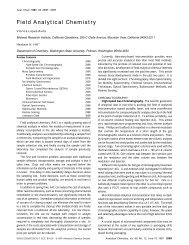
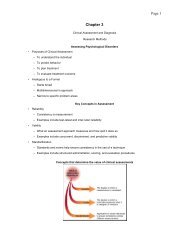
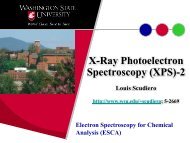
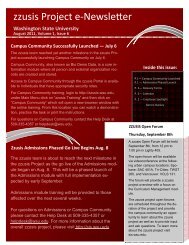
![Graduate School Policies & Procedures Manual 2011 - 2012 [PDF]](https://img.yumpu.com/50747405/1/190x245/graduate-school-policies-procedures-manual-2011-2012-pdf.jpg?quality=85)
